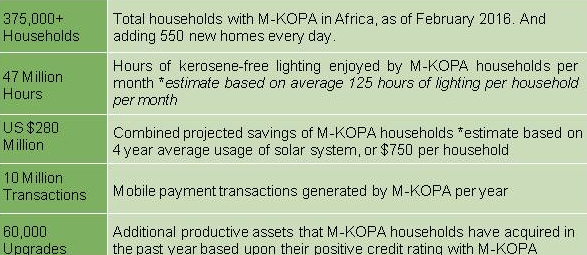Picture a small village somewhere in rural Kenya. Darkness has fallen and there is no light to even go to the fields to relieve yourself. The only succour are kerosene lanterns, that are proven health hazard for the people living in the home.
It was several years ago when UNEP, Nairobi, took us selected journalists from around the world to have a look at the living conditions of women and children and how they cope with fresh water issues in a little village outside Mombasa. The village looked so similar to our villages in India, where women and children walk long distances carrying pots of water from a nearby tank and there is no electricity in the entire village. Over the years solar energy is bringing light into the lives of these villages, lighting up the lives of the poor.
So it is heartwarming to write about M-KOPA, a firm in Nairobi, Kenya, which apparently is the world’s leading ‘pay-as-you-go’ energy provider to off grid homes, like these village homes. They have developed a smart way to provide affordable, safe and clean energy to millions of people who are off the grid and too poor to afford expensive connections.
Using the free rays of the sun combined with mobile technology, customers can light up their homes, charge their phones and tune into radio and TV. They can do all this at the flick of a switch and for less than they spend on kerosene, which is foul smelling and a health hazard.

Caption : Lucas Ochieng, an M-KOPA Solar customer from Kisumu says, “The look on my children’s face on watching TV at home is priceless. They can finally relate with what they see in their books at school.”
” Every night, hundreds of thousands of homes and over a million people in East Africa are using an M-KOPA Solar home system. M-KOPA gives you a lot more light, for less, with our affordable annual payment plan. All you need is a deposit of $30 followed by 365 daily payments of 50 cents, which is paid conveniently by mobile money, ” explains Nikhil Nair of M-KOPA Solar.
Each battery-powered 8W system comes with three lights, mobile phone-charging and a solar powered radio. Customers can now also opt for a 20W system with digital TV. Over a period of time the entire system can be owned by the home owner. After completing the initial one year payment plan, customers can also get more cost effective financing for a range of productive assets. These include more lights, solar TVs, energy-efficient cooking stoves, internet-enabled smartphones, and water storage tanks.

An M-KOPA Solar customer in Kisumu, Jackson Onyango says, “Am happy to share a meal with my family. We get to catch up on our day’s activities after dark, without worrying about the lights going off.”
Coming from India one can see a huge opportunity to electrify our villages and give our poor a better standard of living. The company is interested in supporting only the poor who subsist on under 2$ a day and not the urban rich. Interestingly on 11 July 2016 in Nairobi, Kenya, Prime Minister Narendra Modi met with M-KOPA Solar team to discuss the impact of ‘pay-as-you-go’ solar to millions of low-income off grid homes in Africa. Hopefully his visit will bring back this technology to rural India under the able leadership of Mr Modi.

The reach of M-KOPA Solar
M-KOPA has been build around the money money platform. According to the company, 40% of Kenya’s GDP flows through mobile money. It is as simple as topping up your mobile phone or your Tata Sky connection. As mobile wallets start to take off, especially due to the new RBI regulation around payment banks, the company hopes to see a new business models like M-KOPA emerge out of India.

(L to R: Nikhil Nair, Mr. Modi, Mr. Uhuru Kenyatta- Kenyan President)
Mobile money gives customers the ability to purchase energy according to their cash flow. This is where the role of mobile money, helps in accelerating access to transformational energy, products and services – particularly in low-income homes. The Impact of clean, affordable solar energy that helps wean them off the use of kerosene for low-income homes, as a healthy and clean alternative for the family. So what is the significance of the ‘pay-as-you-go’ model ? It helps in driving digital, social and financial inclusion. What makes the whole venture inspiring is that 85% of M-KOPA households have a per capita income of less than US$2 per day.
With the implementation of the unified payments interface (UPI), mobile money is set to change the face of financial services in India. The experience in Kenya, the home of M-PESA, is that mobile money also provides a platform for a range of products and services – particularly to low-income citizens who subsist below 2$ a day.
Solar powered TV changes the life of the students & teacher in a school
Head quartered in Nairobi, M-KOPA Solar has connected over 375,000 low-income homes to affordable , safe and clean energy in Africa – with 550 new homes being added every day .” We have become the world’s leading ‘pay-as-you-go’ energy provider to off grid homes,” says Nair.
The company’s scalable ‘pay-as-you-go’ platform and mobile technology has enabled customer’s light up their homes, charge their phones and tune into radio and TV. Why can’t we think of this for our villages in India? The joy of a family whose existence can be changed with clean energy, should be the challenge taken seriously in our country, India.
Picture credit M-KOPA Solar/ Allan Gigcihi
Marianne de Nazareth, Former Asst. Editor, The Deccan Herald,Freelance Web & Print Journalist,Registered PhD scholar http://mariannedenazareth.blogspot.com/
















































